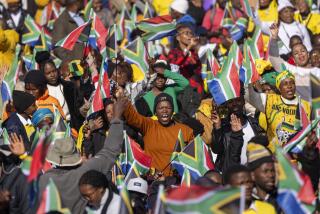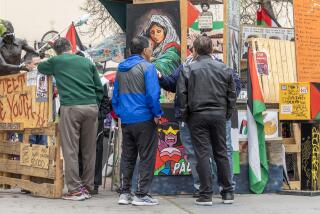Black School-in-Exile : Students Look to Life After Apartheid
MAZIMBU, Tanzania — At sunset on a plateau in Tanzania recently, two dozen teen-agers in shorts and T-shirts were, smartly and in unison, doing a high-stepping trot--the controversial dance popular with young blacks in South Africa known as the toyi-toyi.
In a new library nearby, students were slumped in soft chairs among the stacks of used textbooks, reading week-old copies of South African daily newspapers, such as the Star, the Citizen and Business Day. Outside, the buildings carried the names and pictures of South African rebels.
A tiny, black-run “South Africa” is growing here on an abandoned sisal plantation ringed by blue mountains, far removed from Johannesburg, Pretoria--and black Soweto township, for that matter. It is both an entire school system, for everyone from South African toddlers to adults, and a miniature country, with everything from farms to factories, in the middle of Tanzania.
Educational Heart
The Solomon Mahlangu Freedom College is the educational heart of the African National Congress, the principal guerrilla group fighting white minority rule in South Africa. About 1,000 students are enrolled here, and the number has grown rapidly in recent months as the situation in their homeland has worsened.
“It has reached a crisis point for young people in South Africa,” said Mohammed Tikly, director of Freedom College. “They are not willing to tolerate the lack of freedom anymore.”
Some of those who leave South Africa link up with the African National Congress in Zambia, where the rebel group has its headquarters, or find their way to Angola for guerrilla military training. But many of them head for this isolated spot in East Africa, 1,200 miles from South Africa and a rough, four-hour drive inland from the Tanzanian port of Dar es Salaam.
Once here, they are reminded often that this school, and their home here, is only temporary, an educational system in exile. When discussing the future, students and teachers here tend to conclude with the same phrase: “ . . . when we return to a free South Africa.”
Jimmy Mokgosi left South Africa in 1976 and was in the first group of students here when the high school opened in converted farm buildings, without electricity or running water. He recently finished a master’s degree in Bulgaria and is now the college’s dean of students.
‘Wanting to Go Back’
“We are all wanting to go back to South Africa soon,” he said, “but under new conditions.”
Freedom College, on 3,500 acres of flatland stubble donated by Tanzania, has long, modern red-brick classrooms, laboratories, dormitories and administration buildings. To support the school, and keep the community self-sufficient, there are a medical clinic, a maternity center, a pigpen, a garment factory, a shoe factory, a theater and a lumber yard.
“We are devising an educational system for a future South Africa free of racial aberrations, an educational system for that South Africa of tomorrow,” said Tim Maseko, the chief administrator here. But also, he said, “This is a chance to (practice) running our own country.”
Named After Guerrilla
Freedom College was launched as a secondary school for young people who left South Africa to avoid persecution after the Soweto uprising in 1976 and later. But when it officially opened last year, named for an African National Congress guerrilla who was hanged by the South African government in 1979, it was for students of all ages.
Now, the day-care center has 75 children, the nursery school has 138 children, aged 2 to 6, the primary school serves 300 and the secondary school has about 600 students.
“Enrollment here increases in direct proportion to the increase of violence inside our country,” Maseko said.
The college has been built by donations from the international community. The nursery and playground, for example, were part of a Swedish international development agency project. The nursery rooms are already decorated with the residents’ own drawings of elephants, lions and Walt Disney characters.
The primary school was financed by Austrians, the Nordic Library Assn. donated the library, with 4,000 books, and the administration building was paid for by the Swedish teachers union. The medical clinic was a joint project of the Netherlands and Angola.
So far, donors have pumped about $2.5 million into Freedom College, and half a dozen projects, from extra dormitories to a new soccer field, are under construction.
When black South Africans arrive in Tanzania, they first go to a processing center at Dakawa, about 40 miles from Freedom College, where potential students are separated from those who want to be soldiers or do other work for the African National Congress.
Each student’s educational level is assessed, and some preliminary classes are offered at Dakawa. Arriving students tend to have a weak knowledge of chemistry and biology--but strong political views.
“We’re seeing more and more bitter anti-American and anti-British feelings among students just coming in,” said Tikly, the school director. Many students are angry with the United States and Britain for their reluctance to put pressure on the white-led minority government in Pretoria and for refusing to support African National Congress projects.
“When we have students graduating, needing scholarships to study at universities, the Soviet Union (and other East Bloc countries) have said ‘yes.’ The United States has not,” Tikly said.
Freedom College tries to place its graduates in universities and later seeks positions for them in southern African countries.
The curriculum here includes the usual subjects taught at most schools. But there are a few additions, such as a course called “History of the Struggle,” which examines more than half a century of African National Congress activities.
To keep abreast of developments at home, a group of students monitors international radio broadcasts and African newspapers, then prepares a nightly news reading of the day’s events.
‘Comrade’ Student
The memory of South Africa, and the battle being waged there, is kept alive at the school. Buildings are named in honor of guerrillas who have died in the struggle. Students address each other as “comrade,” a nod to the revolutionary character of the African National Congress.
Groups of youths often move around the campus in a toyi-toyi dance , sometimes singing freedom songs, a familiar scene in the black townships of South Africa. The fast-moving dance is controversial in South Africa: Some whites there fear it, believing it to be a war dance, but others say it is just a release for youthful energy.
Although all the Freedom College students are black, they come from various ethnic groups in South Africa, and the official language of the school is English.
“To highlight ethnicity can cause problems,” explains Maseko, the administrator. “We regard ourselves as South Africans.”
Freedom College is a boarding school, for the most part. The parents of most of the students work for the African National Congress in other countries or have remained behind in South Africa. The 65 teachers come from various countries, and more than a dozen were once students here.
The African National Congress was formed in 1912 to protect the rights of blacks in South Africa. Back then, it was a deferential, polite group that did not question the basic structure of white authority. But it grew progressively more militant, and in its 1955 freedom charter it declared that “South Africa belongs to all who live in it, black and white,” a statement that remains its credo 31 years later.
The group began its life in exile in 1960, when South Africa banned it after a period of racial unrest. It is a multi-racial group, including blacks, Coloreds, Asians and white radicals, some of whom have been members of the Communist Party.
The United States has been reluctant to support the group or encourage Pretoria to negotiate with it because of those alleged Communist ties. President Reagan said two months ago that the goal of the African National Congress is to create “a Communist state” in South Africa.
Secretary of State George P. Shultz, however, has indicated he would like to arrange a meeting with leaders of the guerrilla group, which he calls “an important part of the South African political equation.”
After South African troops attacked what they thought were African National Congress operations in Botswana, Zimbabwe and Zambia last May, college officials became worried about the security of the campus. Guards are posted at the gates, soldiers patrol the grounds and the Tanzanian government forbids journalists to take photographs, for security reasons.
‘You Never Know’
“Some of us feel they (South Africa) won’t strike here because of the kids,” Tikly said. “But you never know what they are capable of.”
The Tanzanian government recently donated 10,000 more acres of land to the African National Congress at Dakawa, where the group is establishing an adult settlement and center for vocational and technical training.
But Tanzania will never be home for these settlers. A Freedom College student, 13-year-old Lentose Serote, wrote a poem not long ago about this life in exile. The poem, displayed on the library bulletin board, says:
In Mazimbu
when I see the mountains,
in Mazimbu
when I see the fields,
I think of my motherland,
I think of South Africa,
dream of my motherland,
dream of South Africa.
MP, Los Angeles Times
More to Read
Sign up for Essential California
The most important California stories and recommendations in your inbox every morning.
You may occasionally receive promotional content from the Los Angeles Times.











